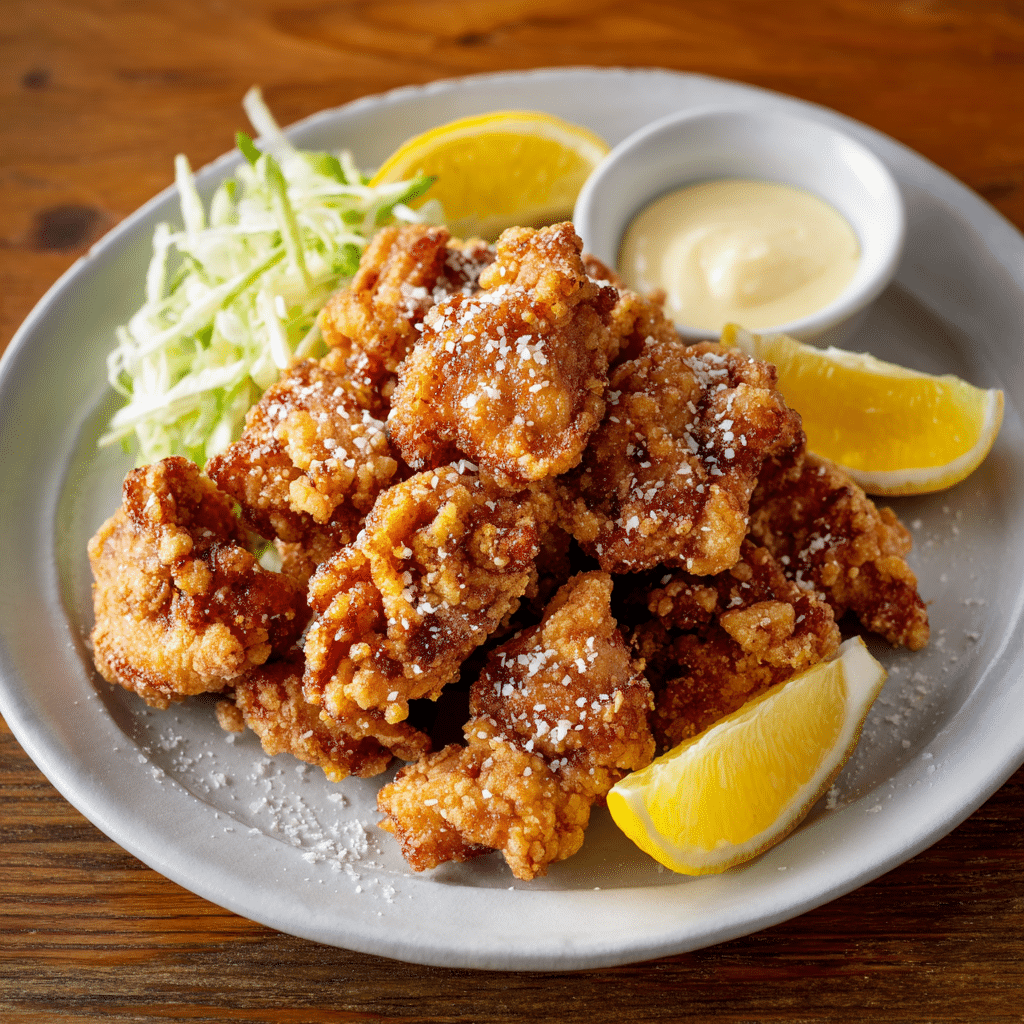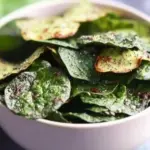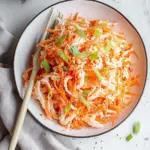Crispy, golden, and flavor-packed, Japanese Karaage is the ultimate fried chicken experience. Unlike Western-style fried chicken, karaage is marinated in a deeply savory mix of soy sauce, sake, mirin, garlic, and ginger, giving each bite a bold, umami-rich flavor. The potato starch coating ensures a crisp exterior, locking in the juicy tenderness inside.
Karaage is a beloved dish across Japan, commonly served in izakayas (Japanese pubs) and bento boxes alike. It’s incredibly versatile — great as a snack, appetizer, or full meal when paired with rice and pickles. The beauty of this recipe lies in its simplicity and incredible crunch. Trust us, once you’ve made homemade karaage, you’ll crave it on repeat.
Full Recipe
Ingredients:
-
1 lb boneless chicken thighs, skin-on preferred, cut into bite-sized pieces
-
3 tablespoons soy sauce
-
2 tablespoons sake
-
1 tablespoon mirin
-
2 teaspoons grated fresh ginger
-
2 cloves garlic, grated
-
1 teaspoon sesame oil
-
1/2 cup potato starch (or cornstarch)
-
Vegetable oil, for deep frying
-
Lemon wedges, for serving
-
Japanese mayonnaise, optional, for dipping
Directions:
-
In a bowl, combine soy sauce, sake, mirin, grated ginger, garlic, and sesame oil. Add chicken pieces and toss to coat well. Cover and marinate in the fridge for at least 30 minutes, or up to 4 hours.
-
Heat 2 inches of vegetable oil in a heavy-bottomed pot to 350°F (175°C).
-
Drain excess marinade from chicken. Coat each piece thoroughly in potato starch.
-
Fry chicken in batches to avoid overcrowding. Cook for 4–5 minutes, turning occasionally, until golden brown and crispy.
-
Remove and drain on a wire rack or paper towels. Let rest for 2 minutes.
-
Optional: Fry again for 30 seconds for extra crispiness.
-
Serve hot with lemon wedges and Japanese mayo on the side.
Prep Time: 10 minutes + 30 minutes marinating | Cooking Time: 15 minutes | Total Time: 55 minutes
Kcal: 375 kcal | Servings: 4 servings
Introduction to Japanese Karaage: A Beloved Classic
Karaage (pronounced kah-rah-ah-geh) is one of Japan’s most iconic and beloved comfort foods. This deep-fried chicken dish is a staple in Japanese cuisine, often found in izakayas (Japanese pubs), street food stalls, school lunchboxes, convenience stores, and family dinner tables. What makes karaage so popular is its irresistible combination of a juicy, tender interior and a thin, ultra-crispy exterior. It’s not just fried chicken — it’s a masterclass in umami and texture that showcases the elegance of Japanese cooking.
Karaage has roots in traditional Japanese cooking methods but has evolved over time with influences from Chinese and Western cuisines. It is traditionally made using chicken thighs, which provide more flavor and moisture than chicken breast, and it is marinated in a flavorful mix of soy sauce, sake, mirin, garlic, and ginger before being coated in potato starch and deep-fried to perfection.
The Unique Flavor Profile of Karaage
What truly distinguishes karaage from other types of fried chicken is its bold and complex flavor profile. The marinade, typically made with soy sauce, sake, mirin (a slightly sweet rice wine), garlic, and ginger, infuses the chicken with umami depth and aromatic warmth. The use of sake tenderizes the meat while also enhancing the other flavors, making each bite both rich and balanced.
The garlic and ginger add a sharp, fragrant note, cutting through the richness of the fried coating and helping to elevate the overall dish. Combined, these ingredients create a harmony that is savory, slightly sweet, tangy, and aromatic — a signature of many Japanese dishes.
Texture Matters: Why Potato Starch Makes a Difference
One of the secrets behind the iconic crispy texture of karaage lies in the choice of coating. Instead of using flour or breadcrumbs, as many Western fried chicken recipes do, karaage is typically coated in potato starch (or sometimes cornstarch). This fine, light starch creates a thin, brittle shell that crisps up beautifully in hot oil without absorbing too much grease.
The result is a golden-brown crust that shatters lightly when bitten into, revealing juicy, tender chicken underneath. Some cooks even fry the chicken twice — a technique known as double-frying — to ensure maximum crispiness and to keep the chicken hot and crunchy for longer.
Cultural Significance in Japan
Karaage holds a special place in Japanese culinary culture. It is comfort food at its finest, often evoking nostalgia and warmth. In Japan, it’s not uncommon to see families prepare karaage for festivals, school field trips, or picnic bento boxes. It’s also one of the top contenders for “best home-cooked meal” in many Japanese households.
It has even inspired regional competitions, such as the “Karaage Grand Prix,” where chefs from all over the country compete to be crowned the best karaage maker. There are countless variations across regions — some use different marinades, spices, or frying techniques — but the heart of karaage remains the same: flavorful, crispy, bite-sized chicken that brings people together.
How Karaage Compares to Western Fried Chicken
While both karaage and Western-style fried chicken share the basic concept of deep-fried, marinated chicken, they are quite different in execution. Western fried chicken often uses a buttermilk soak followed by a flour dredge or a breadcrumb coating, creating a thicker, crunchier, and more textured crust.
Karaage, by contrast, focuses on a light, crackly exterior and a clean flavor that doesn’t overpower the marinade. The Japanese method emphasizes balance — it is less greasy, subtly seasoned, and often served with condiments like lemon wedges or Japanese mayonnaise to enhance but not overwhelm the dish.
Versatility in Serving
One of the beauties of karaage is how versatile it is when it comes to serving. Traditionally served with a slice of lemon or a small dish of Kewpie mayo on the side, karaage can be paired with a wide variety of side dishes.
Common accompaniments include:
-
A simple bowl of steamed rice
-
Pickled vegetables like takuan (pickled daikon) or tsukemono
-
A fresh green salad or shredded cabbage
-
Miso soup
-
Japanese potato salad
It also works beautifully in bento boxes, as part of a rice bowl (karaage don), or stuffed into sandwiches and bao-style buns.
Healthier Versions and Adaptations
Although karaage is traditionally deep-fried, modern cooks have found creative ways to enjoy this dish with less oil. For a lighter version, some people use air fryers or oven-bake the chicken. While these methods can’t fully replicate the deep-fried crispiness, they still produce a delicious result with significantly less fat.
There are also gluten-free versions, where tamari replaces soy sauce and rice flour or cornstarch substitutes for potato starch. Some adventurous variations even swap out the chicken for tofu, mushrooms, or cauliflower to create plant-based karaage.
Why It’s a Must-Try for Home Cooks
Making karaage at home is easier than it looks and delivers incredible rewards. With just a few pantry-friendly ingredients and basic frying technique, you can create restaurant-quality Japanese fried chicken in under an hour. The marinade does most of the heavy lifting, and the frying process is fast and straightforward.
It’s also incredibly forgiving. Because the chicken is marinated first, even if your frying technique isn’t perfect, the flavor will still be on point. This makes karaage a great recipe for both beginners and experienced home cooks looking to expand their repertoire of Asian-inspired dishes.
Pairing Ideas and Meal Inspiration
To create a full Japanese-inspired meal around your karaage, consider pairing it with:
-
A cucumber and sesame salad for freshness and crunch
-
A warm miso soup to balance the fried texture
-
Chilled soba noodles or rice for a neutral, satisfying base
-
Pickled ginger or kimchi for a touch of acidity
-
Ice-cold Japanese beer or green tea as a drink pairing
Karaage also works wonderfully as an appetizer at dinner parties, served with skewers and dipping sauces. You can also wrap it in nori and rice for an on-the-go snack, similar to a Japanese musubi or onigiri.
Conclusion
Japanese karaage is more than just fried chicken — it’s a culinary tradition rooted in flavor, texture, and simplicity. Its iconic marinade brings layers of savory depth, while the crisp, golden coating offers a satisfying crunch that’s hard to beat. Whether served as a weeknight dinner, a party appetizer, or a lunchbox favorite, karaage brings a taste of Japan to your table in the most comforting way possible.
Its versatility, ease of preparation, and universal appeal make it a must-have recipe in any home cook’s rotation. Once you’ve tasted homemade karaage, there’s no turning back — it’s bound to become a dish you return to again and again.






